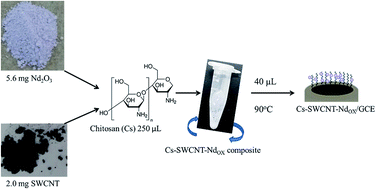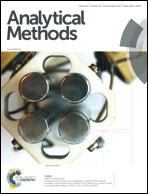New combination between chitosan, single walled carbon nanotubes and neodymium(iii) oxide found to be useful in the electrochemical determination of rutin in the presence of morin and quercetin
Abstract
A glassy carbon electrode surface was modified with a new combination of chitosan, single walled carbon nanotubes (SWCNT) and neodymium(III) oxide (NdOX) and was found to be effective in the detection of rutin (RU), a natural antioxidant. The modified electrode displayed high activity toward the oxidation of RU compared to other flavonoids, such as quercetin (Q) and morin (MO). The oxidation peaks of RU, MO and Q were exhibited at +0.53, +0.42 and +0.39 V, respectively. Moreover, anodic peak currents were 37.27, 10.39 and 2.27 μA, respectively. Cyclic voltammetry (CV) and electrochemical impedance spectroscopy (EIS) were used to characterize the electrode surface, and square wave voltammetry (SWV) was used to quantify RU. The detection limit (3σ/b) was 0.092 μmol L−1, and the RSD was 2.5%. A new sensor was used in the quantification of RU in roasted beans infusion of Coffea arabiga L. and extract of Zamia furfuracea L.f. ex Aiton with satisfactory results.



 Please wait while we load your content...
Please wait while we load your content...